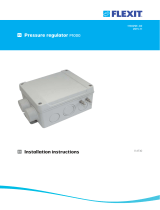English
www.ruck.eu 3
A. EC Declaration of Conformity ............................................................................... 4
B. CE Declaration of Incorporation ........................................................................... 4
1. Important information ............................................................................................ 5
1.1. Rules and regulations ................................................................................... 5
1.2. Guarantee and liability .................................................................................. 5
2. General safety instructions ................................................................................... 5
2.1. Intended use ................................................................................................. 5
2.2. Improper use ................................................................................................ 6
2.3. Personnel qualifi cations ................................................................................ 6
2.4. Safety instructions in this manual ................................................................. 6
2.5. Adhere to the following instructions .............................................................. 7
2.5.1. General instructions ...................................................................................... 7
2.5.2. During installation ......................................................................................... 7
2.5.3. During commissioning .................................................................................. 7
2.5.4. During operation ........................................................................................... 7
2.5.5. During cleaning ............................................................................................. 7
2.5.6. During maintenance and repair .................................................................... 7
2.5.7. Disposal ........................................................................................................ 7
2.6. Safety labels on the product ......................................................................... 8
3. Delivery contents .................................................................................................... 9
4. Product and Performance description ................................................................. 9
4.1. Device description ........................................................................................ 9
5. Transport and storage .......................................................................................... 12
6. Assembly ............................................................................................................... 12
6.1. Duct connections ........................................................................................ 13
6.2. Medium connections / Heating Coil ............................................................ 13
6.3. Condensate drainage ................................................................................. 13
7. Electrical connection ........................................................................................... 14
7.1. Overcurrent protection ................................................................................ 15
8. Commissioning ..................................................................................................... 15
9. Operation ............................................................................................................... 16
9.1. Control unit ................................................................................................. 16
9.1.1. Adjustment of the control unit parameter .................................................... 16
9.2. Menu management ..................................................................................... 17
9.3. Menu functions ........................................................................................... 18
9.3.1. Time / Time switch ...................................................................................... 18
9.3.2. Operating variables Menu .......................................................................... 19
9.3.3. Supply and extract air parameter Menu ..................................................... 20
9.3.4. Parameter settings Menu ........................................................................... 21
9.4 Functions .................................................................................................... 22
10. Maintenance and repair ....................................................................................... 23
10.1. Important notes ........................................................................................... 23
10.2. Cleaning and care ...................................................................................... 23
10.3. Maintenance ............................................................................................... 24
10.3.1. Rotating wheel heat exchanger .................................................................. 24
10.3.2. Belt drive for rotating wheel ........................................................................ 24
10.3.3. Air fi lter ........................................................................................................ 25
10.3.4. Changing the battery .................................................................................. 25
11. Expansion and reconfi guration ........................................................................... 26
12. Dismantling and disposal .................................................................................... 26
12.1. Disassembling the product ......................................................................... 26
12.2. Disposal ...................................................................................................... 26
13. Troubleshooting ................................................................................................... 26
13.1. Low-current fuses ....................................................................................... 26
13.2. Fault diagnosis chart .................................................................................. 27
14. Technical data ....................................................................................................... 28
15. Appendix ............................................................................................................... 30
15.1. List of parameters
....................................................................................... 30
15.2. Wiring diagrams .......................................................................................... 31
Assembly and Operating Manual
Contents






















